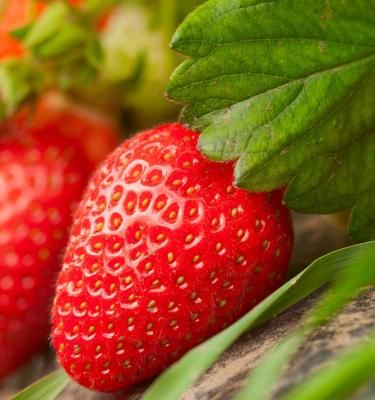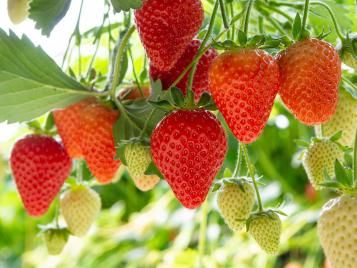

The Ultimate Guide To Grow, Plant and Care for Strawberries
Who doesn’t love strawberries? If you’re a strawberry fan, the many varieties of ‘Fragaria × ananassa’ are easy to grow at home, allowing you to enjoy the perks of harvesting ripe fruits in your own garden. What all strawberry growers will soon realise – you’ll be having the juicy fruit with everything, as just one plant can be a prolific cropper.
Understanding the different types of strawberry
Strawberries are either summer-bearing or everbearing. Summer-bearing strawberries tend to grow bigger fruits and produce one larger harvest over a two-week period in the summer. The exact timing depends on the cultivar. These larger harvests are ideal if you plan to make jam with your strawberries, as you will require a glut of fruit in order to do this.
Everbearing plants, also called perpetual strawberries, produce fruit all season, but in smaller numbers and more sporadically. This type of strawberry is ideal to snack on fairly regularly, or for small harvests to enjoy at breakfast for example.
It’s also worth mentioning the alpine, or wild strawberry, Fragaria vesca. Technically an everbearing strawberry, it also does well in gardens. The fruits are small and a bit dry but with an intense flavour. They spread easily and make excellent groundcover, which is another perk as the dainty leaves are ornamental.
Strawberry varieties
Strawberries come in a range of different shapes, sizes, flavours and cropping times. The main summer-fruiting varieties are divided into early, mid, and late-season types. There are also perpetual or everbearing varieties that can fruit more-or-less continuously from July to September.
Some of the best varieties include:
- Early summer fruiting Emily, Honeoye
- Midseason Cambridge Favourite, Hapil, Pegasus
- Late season Rhapsody, Symphony
- Perpetual fruiting Aromel, Bolero
Your local garden centre will probably have a selection of different varieties, so you can pick n’ mix your plants for a long cropping period. Make sure you pick strawberry plants with plenty of healthy green leaves, that are fairly compact and not too leggy.

When to plant strawberries
Strawberries are available as bare-root runners, that are best planted in the spring or as young plug and potted plants.
You can plant strawberries at any time of the year, as long as the soil is workable and not waterlogged or frozen. However, mid-spring or early autumn are the ideal times to plant strawberries for an effective and bountiful harvest.
How to plant strawberries
So, you love the taste of strawberries. You’re ready to have them with everything, but your big question is: how to grow them? The great news is that strawberries are simple and straightforward to grow. You do need to make sure you follow some basic guidelines, however. Here’s how to do it.
Examine your strawberry plants
The first step is to examine your strawberry plants prior to planting. Check them for signs of pests and disease and remove any damaged leaves with clean tools. If your new plants are on the small side, you may choose to remove any early flowers or immature fruits. This will encourage the plant to put its energy into producing fresh growth, giving it a better chance of producing higher yields in the summer.
Choosing where to grow strawberries
When left to their own devices, strawberries may become very invasive, which is why many gardeners prefer to grow them in containers. Traditional strawberry planters are specialised containers that allow multiple plants to be grown in a small amount of space. Strawberries grow well in most containers and hanging baskets, as long as drainage holes are present. Try a multipurpose compost as a growing medium and space the strawberries about 20cm (8in) apart.
When planting strawberries, try a sunny location as they fruit well in full sun. They will tolerate part-shade, although fruit yields may be smaller. Strawberries like fertile but well-drained soil. If you are planting them directly in the ground or a raised bed, it’s worth incorporating some manure or general fertiliser into the soil before planting. Space the plants 30-45cm (12-18in) apart, in rows 60-90cm (24-36in) apart
Planting strawberries
Using a trowel, dig a planting hole twice as large as the plant’s root ball. Make sure the plant’s crown, where the leaves meet the roots, is level or ever so slightly proud of the compost surface. Planting strawberries too deep can lead to rot, and planting too high will dry the roots out. Backfill around the plant’s roots and firm down the soil with your hands.
The final stage is optional but certainly helpful. Add a thin layer of straw to the surface of the soil and around the strawberry plants. If straw isn’t available, you can use horticultural grit. This acts as a barrier between the developing fruit and the soil. Fruits resting against the soil surface are vulnerable to rot if the soil is wet, as well as nibbles from hungry insects.
When to harvest strawberries
You are likely to know when to harvest your strawberries as the fruits will have darkened in colour and look juicy. Try to harvest as soon as they are ripe, as this is when they taste their best. Remember to be as gentle as possible when harvesting as this prevents bruising the fruit. If you can, remove the stalk and stem from the plant too.
How to care for strawberry plants
Caring for strawberry plants requires some light maintenance to keep them healthy and productive. The first tip is to water regularly, especially if the plants are growing in a container or raised bed. When watering, aim the flow near the base of the plant, rather than overhead, as the leaves of strawberries can be susceptible to mould when wet.
Regular feeding is also important when growing strawberries, as they are hungry plants. Most gardeners like to use a high-potassium liquid feed every two weeks, such as Miracle-Gro Performance Organics Fruit & Veg feed. This kind of feed encourages flowering; and more flowers means more fruit. Tomato feed will also do the job well.
It’s worth remembering that strawberry plants eventually lose their vigour and usually need replacing every three to four years. In the second or third year, you may decide to propagate baby plants from the runners your strawberries produce. These are the long creeping shoots that snake along the soil and produce daughter plantlets nearby.
However, in the first year, it’s beneficial to remove runners as and when you see them. Cut them off where they meet the mother plant. This encourages your strawberry plants to put more energy into flowering and fruiting.
Common strawberry plant pests and diseases
Grey mould/bortrytis mould
Grey mould is a fungal disease that appears as powdery grey mould at the strawberry stalk, gradually covering the whole fruit, which then rots. Strawberries affected by grey mould should not be eaten.
- Remove any dead leaves or flowers.
- Remove any affected fruit promptly.
- Space strawberry plants well when planting to allow good air circulation.
- There are no chemical controls available for grey mould.
Powdery mildew
Powdery mildew is a fungal disease that appears as a white powdery deposit on strawberry leaves, stunting growth and causing leaves to shrivel. Drought-stressed plants are more susceptible to this disease.
- Dig organic material into the soil before planting to improve soil water retention.
- Space strawberry plants when planting to ensure good air circulation.
- Remove any affected growth promptly.
- Water regularly in dry periods.
Frost damage
Late frosts can damage strawberry flowers, blackening the centres. Damaged flowers will not develop into fruits.
- Avoid planting strawberry plants in frost pockets.
- Protect plants from late frosts by covering them with horticultural fleece at night during cold snaps.
Verticillium wilt
Verticillium wilt is a soil-borne fungus. It causes the leaves of strawberry plants to turn brown and wilt, and eventually the whole plant will die.
- Avoid planting strawberries in ground that has been used in the past three years for tomatoes, peppers or potatoes or other strawberries.
- There is no chemical control for verticillium wilt.
Slugs and snails
Slugs and snails will eat ripe strawberries, and can be identified by the slime trails that they leave, as well as the damage they do.
- Check plants at night and remove slugs and snails by hand.
- Covering the soil around plants with crushed eggshells or grit may have some effect.
- Scatter environmentally-friendly slug pellets if other methods are not sufficient.




